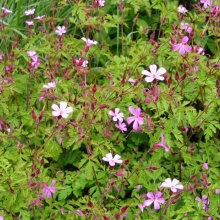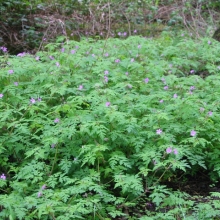
Herb Robert (Geranium robertianum)
Other common names
Herb Robert, Robert Geranium, Stinky Bob, Red Robin, Fox Geranium
Description
A branching, low-growing winter and spring annual. It has light-green leaves that are deeply dissected and release a pungent odor, making this plant easy to recognize. As the plants mature, the foliage turns red. This red color is very noticable under bright light conditions. The stems are highly pubescent, have multiple forks, and are brittle at the joints. The roots are shallow, allowing for easy hand removal. The pink flowers are perfect and five-petaled. The receptacle is elongated into a pointed structure called a "torus" or “storks bill." Herb Robert reproduces only by seeds. Flowers are usually self-fertile, creating uniform populations. Seeds are matured in elongated, pointed capsules that eject up to 20 feet when disturbed. They can survive in the soil up to and probably beyond five years. It tolerates a wide range of light intensities, thriving best in open canopied forests or along the edges of forests. It has been noted that this plant is also very happy under deeper-shaded conditions. It can be highly competitive with native early spring forbs but less so against grasses. Often Herb Robert takes advantage of habitats that have been opened up through weed control activities such as English ivy or False brome removal.
Impacts
Weedy geranium populations have expanded exponentially in the Pacific Northwest in the last ten years. Two species, Geranium robertianum and Geranium lucidum, have aggressively invaded habitats (oak and fir woodlands) only marginally impacted by serious weed invasion in the past. Today Herb Robert is becoming one of the most common woodland invaders in Western Oregon. An annual weed with a high reproductive potential, it has barely begun to infest all potential acreage available to it. Regionally, the species has been dispersed mainly by human activities into many, if not most, watersheds in Western Oregon. Locally, it is spreading by water movement, wildlife, recreationalists, gardeners, and through land disturbance activities. It can develop into populations of high density, up to 250 plants per meter square, pushing out native flora and impacting domestic gardens and parklands. The full impacts of Herb Robert invasion on flora, soil faunal communities, and pollinators have not been examined. Invasive populations in parks and garden settings will increase landscape maintenance costs in some circumstances. Overall economic impact is projected to be minor. Some increased costs related to invasive plant removal projects are probable. Competition to early spring forest forbs has been noted in the Pacific Northwest. The degree of impact this competition provides varies with the density of the weed population. It is unclear whether native species are being completely excluded at some sites or just reduced. Impacts to soil fungus and organisms may occur in situations where monocultures exist. Insect populations, especially native pollinators, may be impacted as weed densities increase. Except in some ecologically significant locations, regional observations of infestations do not indicate that it is currently a serious ecological threat.




